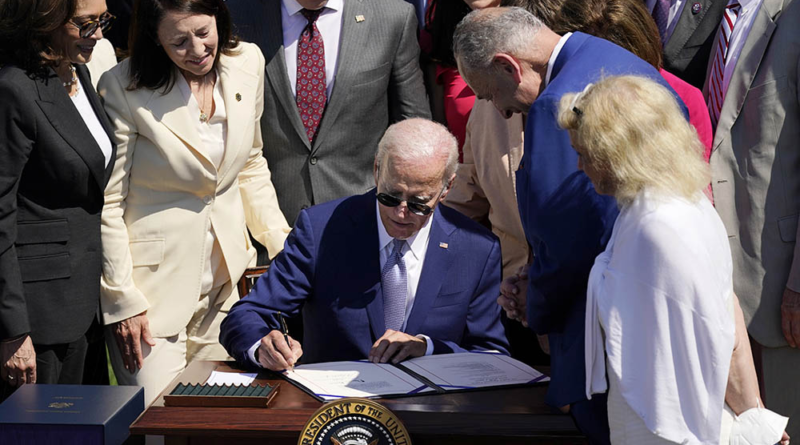CHIPS Act: Semiconductor Stocks Likely To Benefit – Investor's Business Daily
BREAKING: CrowdStrike, KKR, GoDaddy To Join S&P 500
When President Joe Biden recently signed a law to aid the U.S. chip industry, it provided some good news for semiconductor stocks. But the legislation, which will help fund domestic semiconductor production and research, will take years to bear fruit.
The legislation, officially called the “Creating Helpful Incentives to Produce Semiconductors and Science Act of 2022,” or CHIPS Act, provides $52.7 billion in subsidies over the next five years to boost U.S. chip production. It also includes a 25% investment tax credit for chip plants worth an estimated $24 billion over the next decade.
Semiconductors are considered critical components in products ranging from computers, consumer electronics, automobiles and health care equipment to weapons systems. The act aims to rebuild America’s capabilities in chip production.
The U.S. now produces only about 10% of the world’s supply of semiconductors, whereas East Asia accounts for 75% of global production — including all the top-tier chips, according to the White House. In 1990, the U.S. made about 37% of the world’s chips.
The legislation also was designed to address the shortage of semiconductor chips at mature node sizes. Those shortages have caused supply chain disruptions for automakers and producers of appliances and other devices.
Intel (INTC) likely will be the biggest beneficiary of the CHIPS Act, BofA Securities analyst Vivek Arya said in a recent note to clients. He estimated Intel could see $10 billion to $15 billion worth of U.S. government subsidies over the next five years. Meanwhile, Intel is taking advantage of similar semiconductor reshoring initiatives in Europe.
In the U.S., Intel is building a new chipmaking plant in Ohio. It also is expanding its operations in Arizona and New Mexico.
Robert Maire, president of consulting firm Semiconductor Advisors, said Intel probably cares as much about the investment tax credit as it does the grants.
“If I build a $10 billion (chip) factory, which is the current price tag for a bleeding-edge, state-of-the-art factory, I’d get a $2.5 billion rebate from the government for building that facility,” Maire told Investor’s Business Daily.
Other likely beneficiaries of the CHIPS Act include memory-chip producer Micron Technology (MU) and contract chipmaker GlobalFoundries (GFS), Arya said.
Piper Sandler analyst Harsh Kumar agrees that Intel will be biggest recipient of Chips Act funding. But he thinks Intel could reap $19.7 billion from the act.
Kumar sees Micron grabbing $10.3 billion in U.S. funding and GlobalFoundries getting $1.5 billion. He also predicted Texas Instruments (TXN) would get $2.1 billion in CHIPS Act funds.
Smaller U.S. chipmakers will get a slice of the government largesse as well, Kumar said in a recent report. He mentioned Macom Technology Solutions (MTSI), SkyWater Technology (SKYT) and Wolfspeed (WOLF).
Wolfspeed is likely to get funding because of its focus on silicon-carbide chips for electric vehicles and 5G wireless, Kumar said. And Macom and SkyWater could get a higher allocation because of their Defense Department business.
Deutsche Bank analyst Ross Seymore said chipmakers with the largest existing fabrication plants, or fabs, in the U.S. such as Intel, Texas Instruments and GlobalFoundries will benefit most from the CHIPS Act. But so-called “fab-light” chipmakers such as Analog Devices (ADI) and ON Semiconductor (ON) could get a cut as well, Seymore said in a note.
Other semiconductor firms that could get a lift from the act include makers of chip equipment, analysts say. Those companies include Applied Materials (AMAT), KLA (KLAC) and Lam Research (LRCX).
BofA’s Arya called the CHIPS Act “incrementally positive but not a silver bullet” for the U.S. semiconductor industry. It takes years to build new semiconductor factories and get them operational, he noted.
“Any meaningful CHIPS Act output is unlikely before 2024 or 2025 given time taken for fund allocation, clean room construction and tools deployment,” Arya said.
The CHIPS Act includes $39 billion in manufacturing grants. That includes $2 billion for the legacy chips used in automobiles and defense systems. The rest of the funding is for research and development and workforce training and development. Research areas covered include nanotechnology, quantum computing, and artificial intelligence.
The Commerce Department will decide how the CHIPS Act funding is allocated.
The U.S. is seeking to strengthen its competitiveness in the semiconductor industry after years of losing ground to Taiwan’s TSMC (TSM) and South Korea’s Samsung. The U.S. also is concerned about the growing threat posed by China in the market.
However, analysts are skeptical that Intel can catch up to TSMC and Samsung in leading-edge chip production. Instead, the best bet for the U.S. is to incentivize TSMC and Samsung to build factories stateside. TSMC already is planning a new factory in Arizona while Samsung is eyeing new factories in Texas.
TSMC and Samsung are foundries that make chips for fabless semiconductor firms such as Apple (AAPL), Qualcomm (QCOM), Advanced Micro Devices (AMD) and Nvidia (NVDA).
Spurred by the passage of the CHIPS Act, companies already have announced additional investments in American semiconductor manufacturing.
On Aug. 8, GlobalFoundries disclosed an expanded supply agreement with Qualcomm. The White House said the partnership includes $4.2 billion to make chips. It’s part of an expansion of GlobalFoundries’ factory in Malta, N.Y.
On Aug. 9, Micron announced plans to invest $40 billion through the end of the decade. It plans to build leading-edge memory chips in the U.S. Further, it expects to begin production in the second half of the decade.
Follow Patrick Seitz on Twitter at @IBD_PSeitz for more stories on consumer technology, software and semiconductor stocks.
YOU MAY ALSO LIKE:
Micron Warning Pulls Down Semiconductor Stocks
Chipmakers For Consumer Devices See Slowing Sales Ahead
Chip Shortage Spurs Cautious Silicon Wafer Makers To Expand Capacity
IBD Stock Of The Day: See How To Find, Track And Buy The Best Stocks
Find Today’s Best Growth Stocks To Watch With IBD 50
6/07/2024 Track the latest news and trends for the leading chip stocks like Nvidia, Intel and Qualcomm, as well as the…
6/07/2024 Track the latest news and trends for the leading chip…
Mid- and upper-tier consumers are driving growth at chains like Cava, Sweetgreen and Chipotle. But it’s another story at other restaurants. (© Dave Cutler)
Get instant access to exclusive stock lists, expert market analysis and powerful tools with 2 months of IBD Digital for only $20!
Get market updates, educational videos, webinars, and stock analysis.
Learn how you can make more money with IBD’s investing tools, top-performing stock lists, and educational content.
Notice: Information contained herein is not and should not be construed as an offer, solicitation, or recommendation to buy or sell securities. The information has been obtained from sources we believe to be reliable; however no guarantee is made or implied with respect to its accuracy, timeliness, or completeness. Authors may own the stocks they discuss. The information and content are subject to change without notice.
*Real-time prices by Nasdaq Last Sale. Realtime quote and/or trade prices are not sourced from all markets.
Ownership data provided by Refinitiv and Estimates data provided by FactSet.
© 2000-2024 Investor’s Business Daily, LLC. All rights reserved



